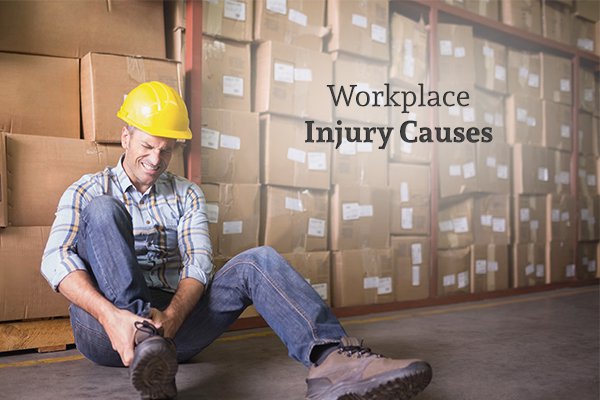When many people think about workplace injuries they tend to picture dramatic accidents involving power tools, falling from big heights, etc. But the most common injuries are more low-key, such as a burning wrist pain after typing all day, or tweaking your back when you lift a box of office supplies. These workplace accidents aren’t as dramatic, but they can still be debilitating. Even minor injuries can cost the worker and the company.
What Are the Most Common Workplace Injuries?
In the USA, there are 4.5 million reported injuries in the workplace each year. That works out to one every seven seconds. However, this statistic doesn’t cover injuries that the workers don’t report or seek treatment for. The real number of workplace injuries may be much higher.
The National Safety Council reports that 84% of nonfatal workplace injuries are from these three causes:
- Overexertion and Bodily Reaction (31%)
- Slips, Trips and Falls (27%)
- Contact with Objects or Equipment (26%)
The overexertion category covers everything from excessive physical effort (like straining your back when lifting something heavy) to repetitive motion injuries (like carpal tunnel syndrome). Slips and falls include common accidents such as falling off a ladder and tripping over objects on the floor. Contact with objects and equipment covers instances like getting hit by stock falling off of the shelves.
How Serious Are These Injuries?
According to the Bureau of Labor Statistics, 37% of workplace injuries in private industries required a visit to a medical facility. In cases where the worker went to the emergency room, they missed a median of 7 days of work. Those who did require hospitalization missed a median of 41 days.
It’s important to note that these statistics are only for hospitals and emergency rooms. Urgent care facilities, infirmaries, and clinics were not part of the study. Less serious injuries treated at such facilities conceivably led to fewer days of missed work.
What Causes Workplace Injuries?
There are two main factors in play here: the worker and the working environment. Personal factors could include:
- overall health including smoking, drinking and obesity
- poor sleep, hydration or nutrition
- improper work practices such as lifting objects with poor form
- ignoring early warning signs of injury until it gets much more serious
Certain issues in the workplace may increase the chance of injuries, such as:
- poor ergonomics of the workstations, making it difficult for workers to do tasks safely or with ideal posture
- high repetition of tasks, every 30 seconds or less
- little to no training and education on how to handle equipment or perform tasks
- unclear safety procedures
What Can Be Done About Workplace Injuries?
The most effective strategy here is three-fold. It begins with pre-employment screening and testing. On the job, accident prevention is the priority, by creating a safer working environment and by helping employees build safer work habits. Finally, injuries that occur must be treated quickly and effectively.
Screening and Testing
Many companies require that employees get pre-employment physicals. These exams can identify underlying health conditions. They also certify that the employee is healthy and able for the job. Finally, pre-employment testing may be required by state and federal regulations.
After employment, these services may be part of yearly physical exams. Testing may also be requested when an employee has been exposed to an illness on the job. Screening and testing may include:
- tuberculosis skin tests
- COVID-19 testing
- drug and alcohol screening
- vision screening
- biometric exams
- EKGs
- vaccinations like tetanus and the flu
- lab results, either in-house or via send-out services
Prevention
Prevention is the most important line of defense against workplace accidents. Safety equipment such as goggles and back braces, along with ergonomically designed workspaces, can reduce the chance of injury. Employers can also implement procedures such as:
- promptly cleaning up spills
- marking on the floor how far away the workers must stay from equipment
- educating people on how to do their tasks safely and efficiently
- working frequent breaks into schedules that require a lot of repetitive motion
- identifying early signs of repetitive stress injuries, so adjustments can be made
- creating a workplace culture of safety
- building a partnership between the company and the workers for a healthy working environment
Treatment
What about after an injury has occurred? Serious injuries, especially those that appear potentially life-threatening, should be taken to the emergency room. In these cases, every second counts for getting the best long-term outcome.
If the injury not severe, but is complicated by an underlying condition or long term illness, you may be better off making an appointment with your primary care physician. Your PCP can give advice based on an understanding of your complete medical situation. They’ll also be able to refer you to a specialist if needed.
The ER and your physician have their place, but an increasingly utilized middle way is the urgent care facility. These facilities typically charge a fraction of the ER while treating an extensive range of conditions, and they have short to no waiting times. And they typically welcome walk-ins. Urgent cares are usually open into the evenings and through the weekends, offering an obvious convenience for working people.
All of these options will provide professional diagnosis, without which no treatment is possible of course. Dr. Gregory Blomquist, Chief Medical Officer at CommunityMed Family Urgent Care, points out that when it comes to diagnosis, sooner is better than later, but “diagnosis should also be followed with appropriate treatment equally expeditiously, for the best outcome.”
Prompt attention after an accident could prevent a condition that lingers or worsens, which in turn could put you at risk for future accidents.


Excellent, that is a very informative article, thanks a lot for sharing